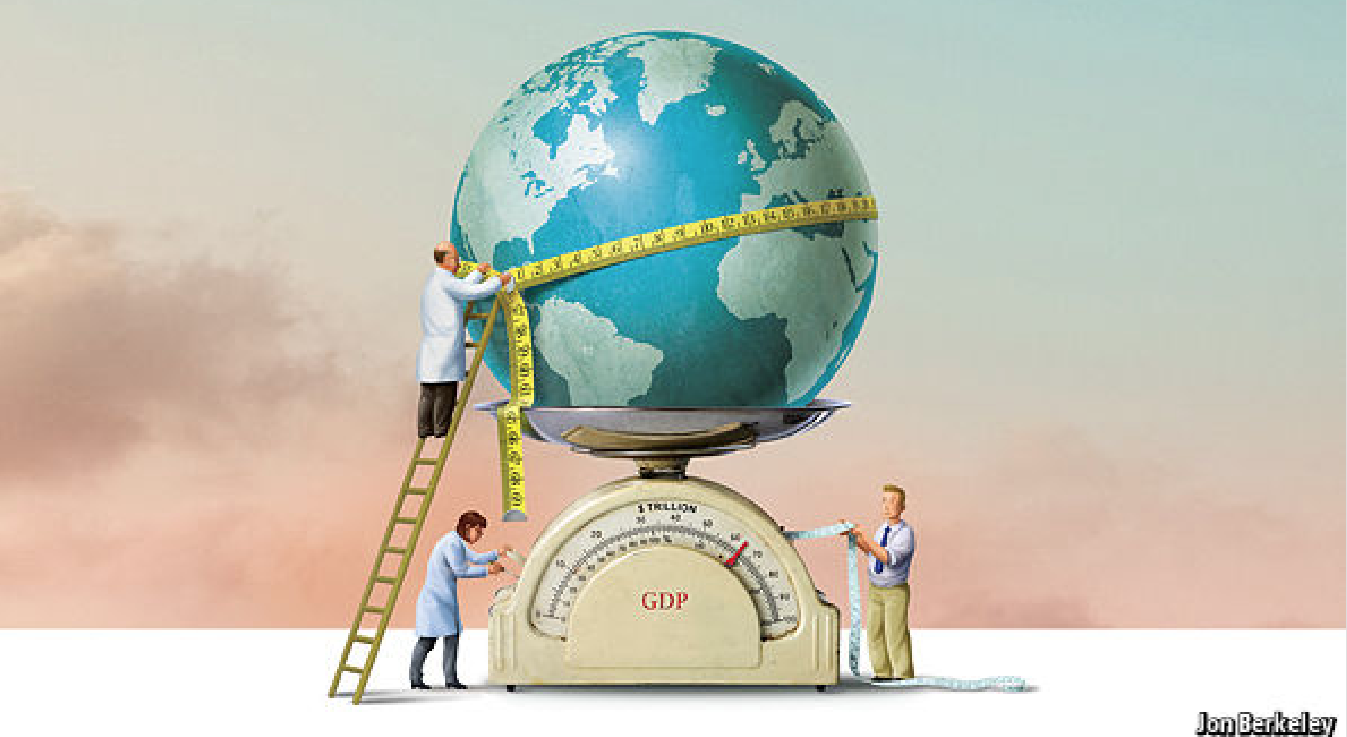By Ray Williams
June 26, 2020

GDP is a poor measure of progress. We need a ‘quality adjusted’ GDP linked to transactions which recognize how much social and natural capital they are building.
What GDP is and What it Isn’t
The OECD defines GDP as “an aggregate measure of production equal to the sum of the gross values added of all resident and institutional units engaged in production (plus any taxes, and minus any subsidies, on products not included in the value of their outputs).”An International Monetary Fund (IMF) publication states that “GDP measures the monetary value of final goods and services—that are bought by the final user—produced in a country in a given period of time (say a quarter or a year).”It has been used by countries since 1944.
GDP can be determined in three ways, all of which should, in principle, give the same result. They are the production (or output or value added) approach, the income approach, or the speculated expenditure approach.
The most direct of the three is the production approach, which sums the outputs of every class of enterprise to arrive at the total. The expenditure approach works on the principle that all of the product must be bought by somebody, therefore the value of the total product must be equal to people’s total expenditures in buying things. The income approach works on the principle that the incomes of the productive factors (“producers,” colloquially) must be equal to the value of their product, and determines GDP by finding the sum of all producers’ incomes.
GDP can be contrasted with gross national product (GNP) or, as it is now known, gross national income (GNI). The difference is that GDP defines its scope according to location, while GNI defines its scope according to ownership. In a global context, world GDP and world GNI are, therefore, equivalent terms. GDP is product produced within a country’s borders; GNI is product produced by enterprises owned by a country’s citizens.
Criticisms of GDP as a Measure of Progress
Former International Monetary Fund head Christine Lagarde, Nobel prize-winning economist Joseph Stiglitz and MIT professor Erik Brynjolfsson noted at the recently concluded World Economic Forum in Davos, Switzerland, “GDP is a poor way of assessing the health of our economies and we urgently need to find a new measure.”
World Economic Forum’s chief economist Jennifer Blanke writes in this in-depth explainer on GDP, “the evolution of GDP remains a fixation for governments around the world and it is also a regular topic on the agenda of global and regional groupings”, such as the 2016 Spring Meetings of the IMF and World Bank.
But amid this obsession, Blanke argues, “it’s easy to forget that it was not initially intended for this purpose, it merely provides a measure of the final goods and services produced in an economy over a given period, without any attention to what is produced, how it’s produced or who is producing it.”Put simply, focusing on GDP growth is not the way forward. She writes: “GDP is a partial, short-term measure, whereas the world needs more wide-ranging and responsible instruments to inform the way we build the economies of the future.”
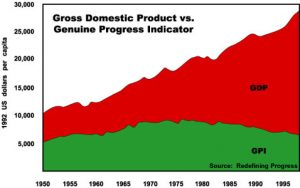
Here’s some of the criticisms
1. GDP Doesn’t Include Increases to Standards of Living
One supposed flaw within GDP calculations is that measuring solely by price inherently undervalues certain products by discounting their contributions to overall productivity and standards of living. Medical breakthroughs, for example, are quantified solely by the price of the treatment, ignoring the benefits of shorter hospital stays and longer life expectancies they create. In the same vein, as the Council of Economic Advisers itself points out, improvements in infrastructure such as indoor plumbing and electricity provide a public good well beyond their market prices, as these services facilitate massive improvements in both production capabilities and quality of life.
2. GDP Doesn’t Include Negative Effects on Nature
Another point of contention with traditional GDP calculations is that it is ill-equipped to counterbalance the negative effects of events against the positives. Perhaps the most important issues here relate to nature. After a large natural disaster, the subsequent rebuilding efforts require a substantial amount of development and investment, providing a temporary surge in GDP. Yet no one would argue that individuals, or the economy as a whole, are actually better off in the immediate aftermath of catastrophe. Environmentalists would take this logic a step further, arguing that GDP actually incentivizes short-term growth at the expense of long-term global health because it does not take into account the value of things such as clean air and sustainable means of production. One modern day example of this phenomenon can be found in the arguments for and against energy development policies such as fracking.
3. GDP Doesn’t Include Household Production
Perhaps the largest complaint with GDP is that does not take into account so-called household production, leaving groups of individuals such as stay-at-home moms entirely out of the calculations. While this is accurate from the perspective of counting the amount of money exchanging hands for the service, it acts to completely discount the productivity of the act. This creates an incongruity where a nanny being paid to watch a child contributes to GDP, while a mother staying at home and providing that service herself does not. The same logic applies to individuals who fix their own cars rather than hiring mechanics, or even those who paint a room in their house rather than hiring a professional. While the purchase of the paint from the local hardware store (or the purchase of baby formula and diapers) will count towards GDP, the time, labor and resulting productivity of the individual’s work will not. (For related reading, see: Limitations of GDP and Alternative Measures.)
4. GDP counts “bads” as well as “goods.”
When an earthquake hits and requires rebuilding, GDP increases. When someone gets sick and money is spent on their care, it’s counted as part of GDP. But nobody would argue that we’re better off because of a destructive earthquake or people getting sick.
5. GDP makes no adjustment for leisure time.
Imagine two economies with identical standards of living, but in one economy the workday averages 12 hours, while in the other it’s only eight. Which country would you rather live in?
6. GDP doesn’t adjust for the distribution of goods.
Again, imagine two economies, but this time one has a ruler who gets 90 percent of what’s produced, and everyone else subsists — barely — on what’s left over. In the second, the distribution is considerably more equitable. In both cases, GDP per capita will be the same, but it’s clear which economy I’d rather live in.
7. GDP is born of the manufacturing age.
It measures “things you can drop on your foot”. Yet in advanced economies such as the US, up to 80% of production is in the service industry. GDP doesn’t do services – at least not very well. It is good at quantity, but lousy at quality. If the food or service improves in your local restaurant, GDP will not notice. Ditto, if an airline’s safety record improves. In fact, GDP might prefer a plane crash – so that it can build a new plane.
8. GDP is flummoxed by the Internet.
If I buy my own cheap airline ticket, check myself in online and pick my own aisle seat, my convenience has gone up. But GDP has gone down. I am my own travel agent, a job that would once have been performed by a fully paid-up GDP-producing employee. Wikipedia provides all human knowledge free of charge. In GDP terms, it is worth zilch.
9. GDP deals in aggregates; GDP per capita in averages.
In an age where a huge cause of social dislocation is inequality, GDP has nothing to say about distribution. Averages are misleading. Medians are better than means. A rise in average GDP could actually be retrograde, if it leaves 99% of people resentful at how the 1% is making good.
10. From GDP’s perspective, bigger is always better.
In the real world, that is not always so. When the financial sector got bigger and bigger, it ended in financial crisis. When the US health service gets bigger and bigger, it means costs are out of control.
11. In general, GDP measures only cash transactions.
In Europe that includes heroin and prostitution. However, volunteer work, housework or looking after an ageing relative count for nothing. GDP has skewed priorities.
What are the Alternatives to Measuring GDP?
Wealth creation is not just the creation and accumulation of financial capital – it is also the creation of environmental and social capital. Catherine Rampell provides a nice summary of the alternative measures that have been proposed, including China’s “green GDP,” which attempts to adjust for environmental factors; the OECD’s “GDP alternatives,” which adjust for leisure; the “Index of Sustainable Economic Welfare,” which accounts for both pollution costs and the distribution of income; and the “Genuine Progress Indicator,” which “adjusts for factors such as income distribution, adds factors such as the value of household and volunteer work, and subtracts factors such as the costs of crime and pollution.” Finally, there are more direct measures of well-being such as the Happy Planet Index, Gross National Happiness and National Well-Being Accounts.
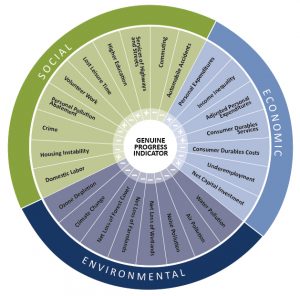
Since the institution of GDP figures and country rankings, other measures of the quality of life have appeared. For example, The Organization for Economic Cooperation and Development (OECD) annually issues a report based on a study of 140 countries, indicating the levels of happiness in those countries. For at least the last decade, European countries such as Denmark, Finland, and the Netherlands and other countries such as Canada, Australia and New Zealand have ranked at the top and the U.S. has not made the top 10.
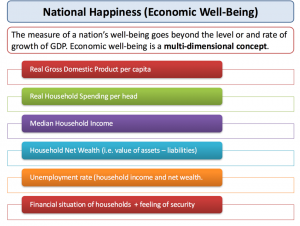
Why did some countries come out on top? Certainly overall economic health has played a powerful role. For example, Denmark, which got the highest score, is not only a wealthy country, it’s also highly productive with a 2009 GDP per capita of $68.000 (U.S.) according to the International Monetary Fund. In contrast, the U.S. GDP per capita was $47,335. But wealth alone does not bring the highest happiness score, according to the report. Norway had the highest GDP per capita at $98,822, yet it ranked 19th, not first. On the other hand, New Zealand, which was ranked 8th, had a GDP per capita of $30,556.
So what are other factors that may account for happiness levels? According to the British Medical Journal article by Dr. Tony Delamothe, research done in Mexico, Ghana, Sweden, the U.S. and the U.K. shows that although individuals typically get more wealthy during their lifetimes, they don’t get happier. Rather, argues Delamonthe, family, social and community networks bring joy to one’s life.
Work-Life Balance
Another important factor is work-life balance. While the Scandanavian countries boast high GDPs, the average workweek in those countries is no more than 37 hours per week. In contrast, the average worker in the U.S. may be the hardest working employee in Western countries, according to the UN International Labor Organization, working far more hours now than a generation ago, with a negative net increase in the standard of living.
World experts on the subject of happiness, Dr. Ed Diener and Dr. Sonja Lyubomirsky and Dr. Martin Seligman, have concluded that beyond the basic level of necessities to support life, such as adequate, food, water, housing, the following things can increase happiness levels: meaningful close relationships; a positive, optimistic frame of mind; accepting responsibility for your life; being engaged in meaningful work; living in the present; and practicing an altruistic life, including gratitude forgiveness and compassion.
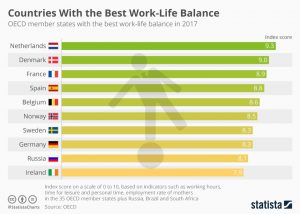
While The U.S. Leads the World in GDP, it Falls Far Behind on Other Measures
If we look at broad and varied data other than GDP, the picture for the U.S. is not rosy. According to the U.N., the OECD, The Legatum Institute, The U.S. National Intelligence Council , the U.S. Congress, the CIA and many business publications:
- In 2008, the U.S. had fallen from first to third in global merchandise exports. The U.S. trails Japan for worldwide patent applications, with China soon to bypass both. In 2009, the Information Technology and Innovation Foundation reports that the U.S. ranks last among the 49 nations survey when it came to “change” in “global innovation-based competitiveness” in the last decade.
- After leading the world for decades in 25-34 year olds with university degrees, the U.S. is now in 12 place. The World Economic Forum ranked the U.S. at 52nd among 139 nations in the quality of its university math and science instruction in 2010. According toe the OECD 15 year olds in the U.S. rank 17 in the world in science and 25 in math. The U.S. ranks 12 among developed countries in college graduation. and 79 in elementary-school enrollment. Nearly 50% of all graduate students in the sciences in the U.S. are foreigners, most of whom will be returning to their home countries.
- The Legatum Institute, a London-based research firm publishes an annual “prosperity index” and ranks the U.S. 9, five notches lower than last year. The U.S. poverty level is the third worst among advanced nations according to the OECD. Only Turkey and Mexico are worse. In the Legatum study, the U.S. ranks 27 for the health of its citizens; life expectancy is below average compared to 30 advanced countries measured by the OECD and obesity is the highest in the U.S. among all those countries.
- The U.S. federal government spending as a percentage of GDP is now up to about 36%. The Congressional Budget Office is projecting that U.S. government public debt will hit 716% of GDP by the year 2080.
- More than one quarter of the federal budget is spent on the military. The cost for the Iraq and Afghanistan wars is now creeping up to $10 trillion.
- The U.S. ranks 23 in the world in terms of infrastructure, well behind that of every other major advanced economy. The American Society of Civil Engineers prepared a report card on the state of America’s infrastructure-roads, bridges, dams etc. In the latest version the overall “GPA’ for the U.S. was a “D,” and the cost of bringing all systems up to adequacy, not an “A” was estimated at $2.2 trillion.
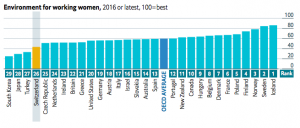
Income Inequality
In their book, The Spirit Level: Why Greater Equality Makes Societies Stronger, Professors Richard Wilkinson and Kate Pickett, present data taken from multiple credible sources that show the gap between the poor and rich the greatest in the U.S. among all developed nations; child well being is the worst in the U.S. among all developed nations; and levels of trust among people in the U.S. among the worst of all developed nations. So income is helpful, but only in certain circumstances.” Diener goes on to argue “Our research contradicts this concept [rich people are happier].”
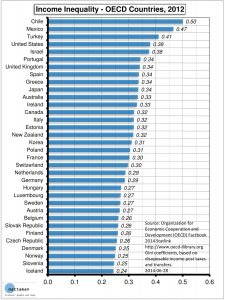
Best Cities In Which To Live
Another measurement of a country’s overall health is Mercer’s World’s Best Cities To Live In report. According to this report, the top cities were Vienna, Zurich, Geneva Vancouver, and Auckland, with the highest ranked U.S. city, Honolulu, coming in 30 place. Similarly, The Economist reports annually on the most livable cities in the world. Factors such as stability, health care, infrastructure and crime are examined in addition to economic activity. Vancouver tops the list of 140 countries along with 2 other Canadian cities, the European cities of Vienna, Helsinki, and Sydney, Australia and Auckland, New Zealand. No U.S. city made the top 20.
Robert Costanza, Mareen Hart, Stephane Posner and John Talberth are authors of a study for the Frederick S. Pardee Center at Boston University. They issued a report arguing for new measures beyond GDP to indicate a country’s progress. They GDP was never designed to measure national well-being. They contend “useful measures of progress and well-being must be measures of the degree to which society’s goals (human needs of food, shelter, freedom, participation, trust) are met, rather than measures of the volume of market economic activity, which is only one means to that end.”
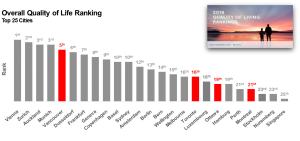
The Social Progress Indicator
They make reference to an alternative measure, called the Social Progress Indicator, originated by the World Economic Forum and advocated by the Social Progress Imperative and Harvard Business School Professor Michael Porter, which examines how 50 countries perform on 52 indicators related to human needs, and foundations of well-being. The results—Denmark was at the top, Canada 6th and the U.S. comes in at number 18.
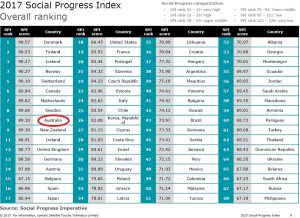
Professor Sir Partha Dasgupta, from The University of Manchester, says Gross Domestic Product (GDP) ignores the value of natural ecosystems — an essential component of wealth.
Aquifers, ocean fisheries, tropical forests, estuaries and the atmosphere, should but are not used to estimate nations’ wealth, he wrote in a new paper published this month.
Professor Dasgupta also criticises the Human Development Index (HDI) — used by the United Nations to say if a country is developed, developing, or underdeveloped for — the same reason.
To support his argument, Professor Dasgupta produced a series of s from 1970-2000, showing that sustainable economic development for most of the third world — other than China — was negative — despite official s showing GPD and/or HDI as rising.
Though the crude data leaves out the deterioration of ecosystems and improving health — among others — by using population, the calculations provide a strong indication of the mismatch between official GDP s and real wealth, he said.
“Adam Smith did not write about the GDP of nations, nor the HDI of nations; he wrote about the ‘Wealth of nations’,” said Professor Dasgupta who is based at the University’s Sustainable Consumption Institute.
In the paper published this month in the Royal Society Journal Philosophical Transactions of biological sciences, Professor Dasgupta argues that twentieth-century economics has been ‘inexplicably’ detached from the environmental sciences.
“As long as we rely on GDP and HDI, we will continue to paint a misleading picture of economic performance,” he said.
“If economists take into account natural capital, then it is clear that some of the world’s poorest people are subsidising the incomes of importer rich countries.”
He added: “Leading economics journals and textbooks take nature to be a fixed, indestructible factor of production.
“The problem with this assumption is that it is wrong: nature consists of degradable resources.
“Agricultural land, forests, watersheds, fisheries, fresh water sources, river estuaries and the atmosphere are capital assets that are self-regenerative, but suffer from depletion or deterioration when they are over-used.”
In Summary
Excessively focusing on economic indicators such as the GDP and stock market indices takes our attention away from the real measurement of a country’s and people’s progress—our overall well being. We would do well to remember Mahatma Gandhi’s observation about the roots of conflict and violence within a nation are “wealth without work, pleasure without conscience, knowledge without character, commerce without morality, science without humanity, worship without sacrifice, and politics without principle.”
Copyright: Neither this article or a portion thereof may be reproduced in any print or media format without the express permission of the author.
Read my latest book: I Know Myself And Neither Do You: Why Charisma, Confidence and Pedigree Won’t Take You Where You Want To Go, available in paperback and ebook formats on Amazon and Barnes and Noble world-wide.


